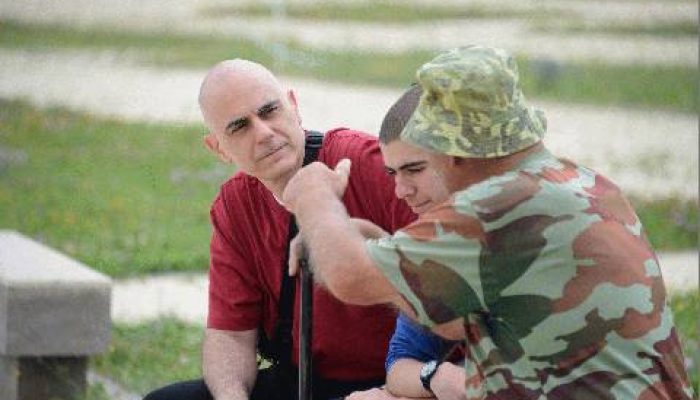BELMONT , Mass. (A.W.)-On Nov. 7, Dr. David Gaunt, professor of history at Södertörn University-Sweden, gave a lecture at NAASR titled “New Evidence Concerning the Genocide of Armenians and Assyrians.” The lecture was jointly presented by NAASR and the United Assyrian Association of Massachusetts. Introductions were presented by Marc A. Mamigonian of NAASR and George Stifo of the UAAM.
Gaunt’s most recent publication is Massacres, Resistance, and Protectors: Muslim-Christian Relations in Eastern Anatolia during World War I (Georgia Press, 2006). He spoke of how he became involved in the research during his previous communication with the Swedish government and the Hague , presenting Holocaust and crimes against humanity research at various international community conferences. He mentioned that whenever the Armenian Genocide was referenced, there would be hecklers among the representatives of the Turkish government. He paused, and noted, “This was most uncommon at a function presented by the Swedish government.”
Sweden has one of the largest expatriate Assyrian populations in the world, and over time, many of Gaunt’s Assyrian students peaked his interest in doing archival research on the Armenian and Assyrian genocides. “I was curious about the assertion of many Turkish government officials that there were no documents that could prove a genocide.” In fact, he stated, “The evidence, especially on the local level, was overwhelming.”
“We [historians] are trying to vacuum clean history for documents anywhere in the world that can help piece together parts of this narrative,” he said, explaining the wide scope of his investigations. To that end, he has examined a variety of sources, from Russian, Italian, French and German sources to. He clarified that his area of expertise is Iran , with a focus on the history of the Assyrians there.
Speaking about his use of archival material and primary source documentation, Gaunt said, “I am one of the few scholars to have had access to archive materials in Ankara and Istanbul .” When asked why he was granted such unprecedented access to materials so often a subject of harassment to other scholars, he said, “At one of these international gatherings, a European parliamentarian said [to Turkish officials], You say the archives are open, show us it’s true.’” As a result, negotiations between the Turkish and Swedish governments allowed Gaunt access to peruse the materials he asked permission about.
“There were many Armenians that did not consider themselves Armenian as much as they did Catholic,” he said. “But during the Genocide they were killed not so much because they were Catholic, but because they were Armenian.” Gaunt read the reports left by missionaries. “They are very full and very sensitive. But it is the military archives that are often most useful because they are usually the first people to come across victims of genocide.”
Gaunt spoke of the atrocities committed. “Many were hung upside down over a well and had their bodies dropped into the well, one by one. Others were decapitated after sticking their head through a ladder, or having walls pushed on top of them. Almost every conceivable method of death was used except shooting, because the Turkish army was low on ammunition supplies.”
He made a point of addressing the Assyrian contribution to the resistance efforts led by the Armenian national hero, General Andranik, by saying, “Many are not aware that there were Assyrian volunteer fighters in Andranik’s forces. They were given arms as well, but Andranik’s forces did not have any cannons, machine guns or the like.”
Of particular significance to his book was a discussion of the Battle of Dilman in 1915, in which Armenian and Assyrian partisans severely routed the Turkish army with the aid of Bolshevik forces, shaming Turkish general Halil Bey, uncle of Enver Pasha. Gaunt said of the battle, “Andranik managed to defeat the Turkish army using really crack troops. They had a super-human motivation to defeat the Turks.” He explained the battle’s consequences as well; the defeat of the Turks led to the creation of the newly formed “butcher battalions” in the Ottoman ranks. “The battle represented the turning point when regular army soldiers were informed that they could turn their weapons upon and kill civilians. Which totally went against their training.”
He quoted Rafael De Nogales, a Venezuelan mercenary in the employ of the Ottoman Empire at the time: “Halil did as he pleased with the Christians after that, for their role in helping the Russian army.”
Gaunt then exhibited a telegram he considered very crucial to his work; he discovered it in the Istanbul archives. It was written in Osmanli script, from the Ministry of the Interior under Talaat Pasha’s authority, and concerned the deportations and removal of the Assyrian communities in Eastern Anatolia . The date on the telegram was Oct. 26, 1914. This was weeks before Turkey was “provoked” by Russia into joining the war on the side of the Central Powers against the Tsar. It rationalized the Assyrian deportations by stating that “They are too susceptible to influence from foreign powers.”
The “foreign powers” in question included the Russians and possibly the British in Persia , Gaunt said. The telegram culminated by saying, “[The Assyrians] masses are not to exceed 20 dwellings.” and “The government is to lend them no assistance while they are in transit. »
He then talked about the inhumanities committed by general Reshid Bey, a doctor and the Turkish authority in command in 1915 over the city of Diyarbakir . Bey was “a psychopath,” said Gaunt, who when subjected to interrogations-even by the Young Turks-over the excess of his killings, replied in defense, “The Armenians were like bacteria, and isn’t it the job of a doctor to rid the body of bacteria?”
Regarding the historical context of the genocides in international law, Gaunt maintained, “Even at that time it was a crime against humanity to kill innocent civilians-even soldiers-if they were unarmed.”
He ended his lecture on a positive note of cooperation and unity. He said, “I hope that my contribution tonight has shown that the experience of the Armenians and Assyrians is interlocked and that even when they defended themselves, valiantly, there still have been dire consequences for their communities.”



